Saint Spyridon of Corfu Greece

Saint Spyridon the Miracle Worker
Saint Spyridon (270 – 348 A.D), Bishop of Trimythous and Patron Saint of the Greek Island of Corfu (Kerkyra in Greek) whose Feast day is celebrated on the twelfth of December, was born in the small village of Assia, Northern Cyprus.
The life of Saint Spyridon
Spyridon (Spyros) a humble shepherd, was a simple, private man and being devoted to God from a young age he became the village priest, whose parishioners he constantly put before himself, using all his worldly goods for their needs.
For his good deeds, it’s said that God rewarded him with the powers of healing and the ability to cast out demons.
Spyridon married and had a daughter however, his wife suffered an early death, after which, he entered a monastery, following in his footsteps, his daughter Irene, entered a convent.
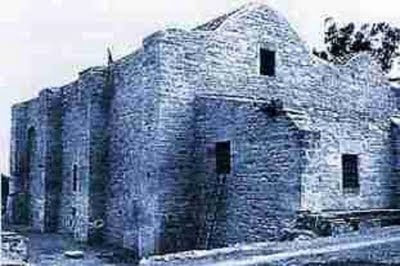
Saint Spyridon, Assia Northern Cyprus
Spyridon was eventually ordained as Bishop of Trimythous (Today Tremetousia, Cyprus) and was present at the first Council of Nicaea, 325 A.D, where he is said to have converted a disbeliever, by proving to him, how one single body could contain three separate bodies:
The Holy Trinity; Father, Son and Holy Ghost.
To prove the concept of The Holy Trinity, Spyridon took a potshard and said to the pagan;
“This one potshard contains three separate bodies, fire, water and earth” .
Miraculously, as Spyridon was speaking, the potshard burst into flames in his hand, water dripped to the ground and he was left holding only clay.
This is explains why icons of Spyridon show him holding a flaming potshard, or brick and is why he is also the Patron Saint of potters.
Other symbols are his right hand raised in blessing, or holding a gospel, a sprig of basil and always, his woven straw shepherd’s hat, showing that he never forgot his humble beginnings.

Saint Spyridon of Corfu
Miracles of Saint Spyridon the Wonder-worker
Owing to various miracles worked by Saint Spyridon he was granted the title Wonderworker by the Orthodox Church.
In Corfu he is also called “The Keeper of the City” as he saved the island more than once!

8 miracles of Saint Spyridon the miracle worker.
Below are a few examples of the many miracles performed by Saint Spyridon:
Plague of Corfu 1629
It’s believed that when the dreaded plague hit Corfu in 1629, starting in the villages and quickly spreading to the town, the corfiots gathered together at the church of Saint Spyridon and prayed to him for salvation.
Some days before Easter many of the sick had visions of Saint Spyridon healing them and for three nights strange lights were seen in the bell tower of Saint Spyridon Church.
By Palm Sunday the plague had vanished.
Famine of Corfu 1553
In 1553 Corfu suffered a terrible famine and just as everyone thought this was the end and that they would all die of starvation, out of nowhere, a ship, filled to the gunnels with wheat dropped anchor at the island.
The captain of the ship reported he had seen Saint Spyridon calling to him in a dream, begging him to stop at Corfu as they were in fear of dying of starvation.
Another version of this miracle has Saint Spyridon whipping up a storm at sea, which forces a passing ship with a cargo of wheat, on route to somewhere else, to find safety at the port of Corfu.

St Spyridon’s miracle. St Spyridon is the patron saint of Corfu, Greece, which is depicted in the lower panel of the icon.
Late 17th – early 18th c. G. Aspiotes. Byzantine museum, Athens.
Turkish invasion of Corfu 1716
When the Turks invaded the island in 1716, at the second great siege of Corfu, Turkish soldiers were said to have been so terrified by the sight of Saint Spyridon, dressed as a monk, flying at them, threatening them with a flaming sword, that they fled in a panic.
The siege, which had lasted for twenty two days was over, Corfu was saved.
Second plague of Corfu 1673
In 1673 the plague hit Corfu for the second time, again the inhabitants of the island, congregated at the church, praying for help from Saint Spyridon.
Again mysterious lights were seen in the bell tower and the image of Saint Spyridon was spotted chasing after the plague (which some say looked like a black ghost, others a winged creature, half lion, half monkey), and beating it with a cross.
When it reached the fortress of Corfu, Spyridon had the plague creature scratch a cross into the stone wall and vow never to return.
Abruptly the plague was no more.
Today tourists are still shown the mark at the fortress said to be left by the plague.
The Fortress of Corfu
Saint Spyridon’s daughter, Irene, arises from her grave.
Whilst Saint Spyridon was away at The Council of Nicaea, his daughter, Irene, died.
On his return to Trymithous, Spyridon was accosted by a women declaring she had entrusted some valuables to his daughter’s care and now, with Irene dead, how was she to find out where her valuables were?
Saint Spyridon took the woman to Irene’s grave and talking to her as if she were still alive, asked his daughter where she had put the woman’s valuables.
Irene rose up from her grave, informed the woman of where the valuables were, and promptly returned to her grave and resumed her “sleep”.
Irene is recognized as a Saint, only in Cypress, a fresco of her was painted in the Church of Panagia Assinou, Cyprus in around 1332.

Irene, daughter of Saint Spyridon of Corfu
Fresco in the Church of Panagia Assinou, Cyprus
Relics of Saint Spyridon
Saint Spyridon died in Trymithous, where he was buried, in 348 A.D but when the Saracens invaded Cyprus in 648 A.D, his body was exhumed and taken to Constantinople for burial.
On exhumation the body, although having been buried for three hundred years, was well preserved, and gave out a distinct aroma of basil, the king of herbs, both considered signs of Saints or “Incorruptibles” (Saints and holy men and women whose bodies have not decomposed).
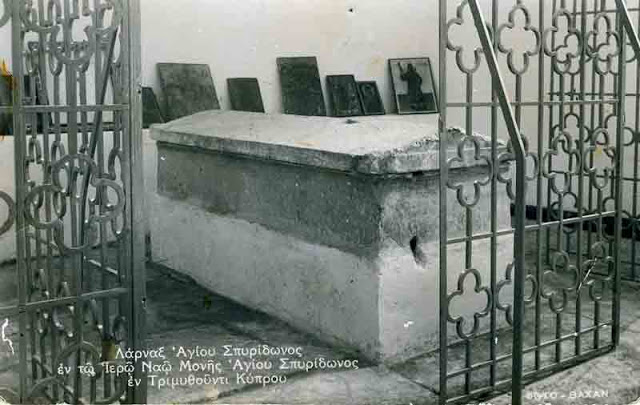
Tomb of Saint Spyridon. Tremetousia Cypress
In 1453 Constantinople fell to the Ottomans and again, Saint Spyridon’s body was exhumed and taken first to Serbia and then to Corfu, where the relics have remained and can still be seen today.
The relics of Saint Spyridon were brought to Corfu under the authority of George Kalohairetis, who passed them down to his son, Luke, who then passed them on to his niece, Asemine, as part of her dowry when she married Stamatios Voulgaris.

Relics of Saint Spyridon. Church of Saint Spyridon, Corfu.
Voulgaris was granted permission to build a private church, where the relics were housed, until the construction of a new church, built in the old town of Corfu in the 1580s, the Saint Spyridon Church, the most famous church of Corfu which has the highest bell tower in the Ionian Islands.
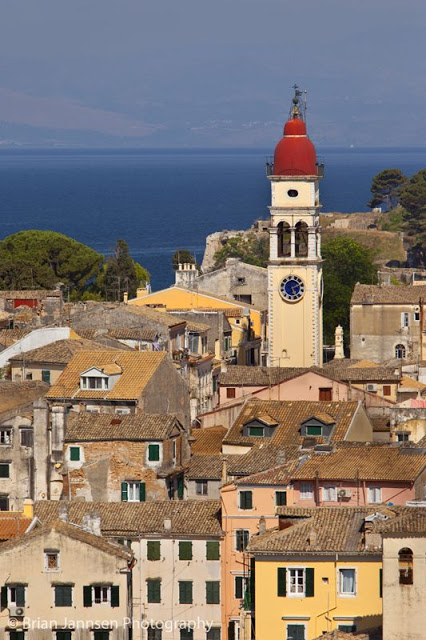
The Church of Saint Spyridon Corfu – Highest bell tower in the Ionian Islands – Photo by Brian Jannsen Photography
Inside the Church of Saint Spyridon is a crypt where his relics are kept in a double sarcophagus and are on view to the public twice a day.
On his Feast Day;12 December in the Eastern Orthodox Church and 14 December in the West, the relics are carried through the town.
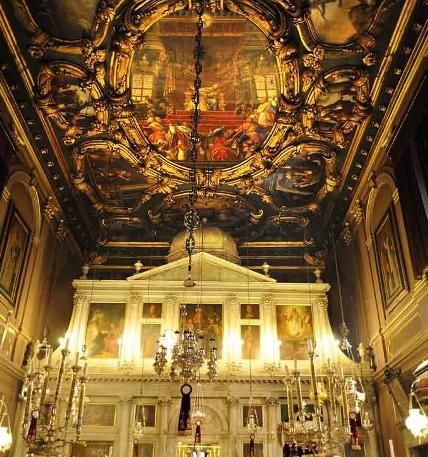
The famous ceiling of St. Spyridon Church, Corfu, divided into panels, dipicting his life & miracles.
Originally painted by Corfu artist Panagiotis Doxara in 1727.
The relics, which are said to have the temperature of a living body and flesh which has remained supple, have been studied and examined by many scientists from around the world, none of them have an explanation for this phenomenon.

Relics of Saint Spyridon Church of Saint Spyridon, Corfu.
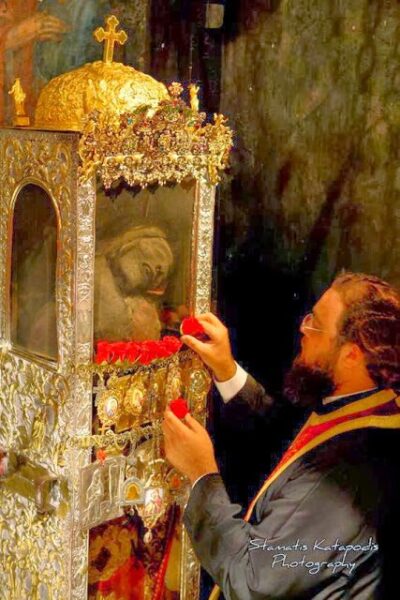
Relics of Saint Spyridon, Saint Spyridon Church Corfu
Saint Spyridon is known as “The walking Saint”, his silk slippers need to be replaced frequently as it’s said they wear out as he walks the world performing miracles.
His coffin has a removable bottom, to make things easier when replacing his shoes, which is done on his feast Day, when thousands of pilgrims visit and kiss his feet

The silk slippers of Saint Spyridon, Corfu
For reasons unknown, the right hand of Saint Spyridon is separate from the body, it’s thought it was taken to Rome ( where it was kept in the Church of Santa Maria in Vallicella), from Constantinople, between 1592 and 1605, more than a hundred years after his body was brought to Corfu.
Church of Santa Maria in Vallicella, Rome Italy
In 1984 the hand was flown to Corfu from Rome and in great pomp and glorywas returned to its owner!

The Right hand of Saint Spyridon, Corfu
The hand of Saint Spyridon has done quite a bit of travelling, among other places, it has visited Russia and in October 2017, America.
Celebrations of Saint Spyridon
Apart from the celebration of his Feast Day, there are four other yearly occasions when the relics of Saint Spyridon are taken around the town; these processions are to celebrate some of the miracles he has performed:
1. Palm Sunday, in celebration of saving Corfu from the plague
2. Holy Saturday, in honour of Corfu escaping the famine
3. 11 August, in commemoration of the defeat of the Turks
4. First Sunday in November, in celebration of the end of the second plague

Procession carrying the relics of Saint Spyridon around Corfu Town
Along with being Patron Saint of Corfu, Potters and Piraeus (the port Athens), Saint Spyridon is the Patron Saint of the Tolstoy family, chosen by Andrei Tolstoy after the Grand Prince of Muscovy, Basil II, gave him a gold cross containing relics of Saint Spyridon in around 1430, this still exists and is now the property of Nikolai Tolstoy, the family’s most senior member.

Statue of Saint Spyridon, South Collonade, St. Peter’s Rome. Sculptor – Lazzaro Morelli – Statue created – c. 1668-1670
As happens frequently in Greece, the name of a Patron Saint of an area, is given to children born there, e.g. Patras has many Andreas, Kefalonia, lots of people named Gerasimos and so Spyros and Spiridoula, for girls, are very popular names in Corfu.
Related links:
Saints and Celebrations of the Greek Orthodox Church



